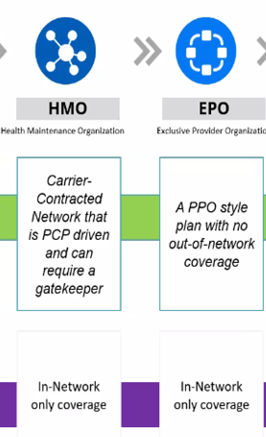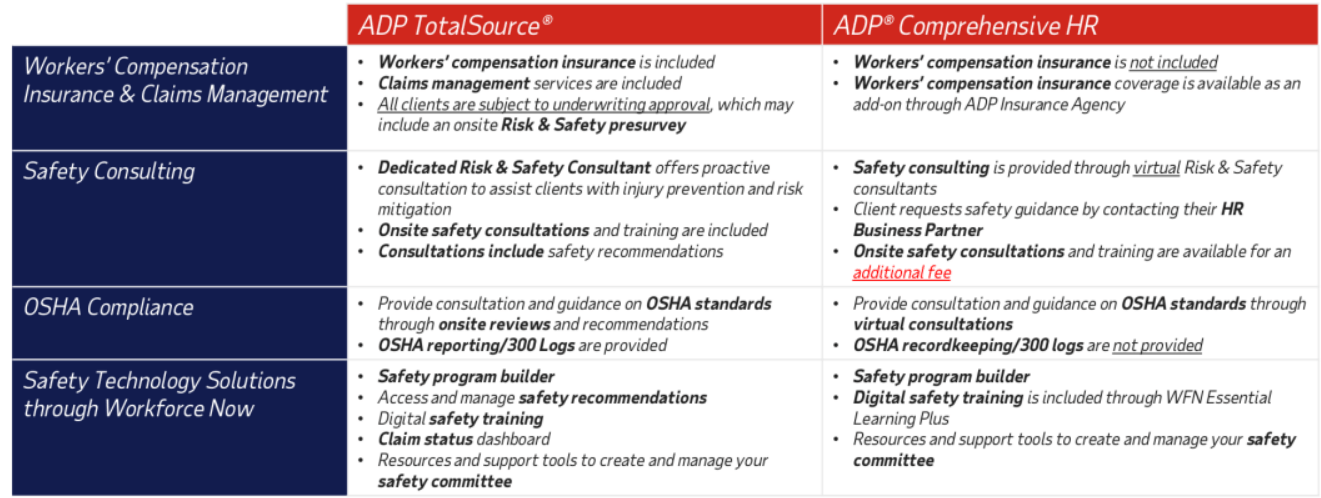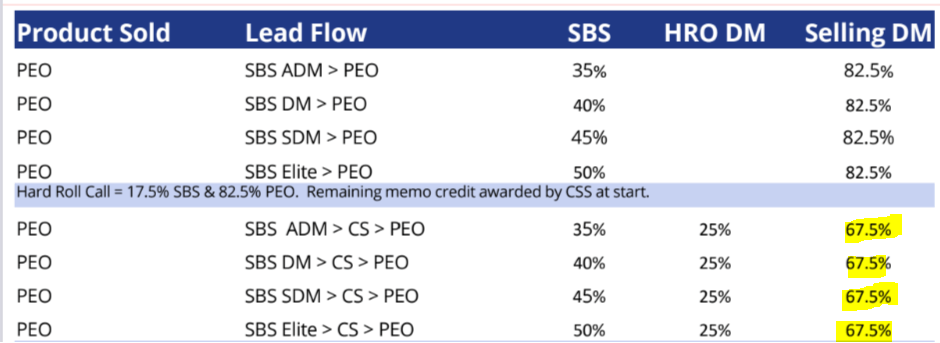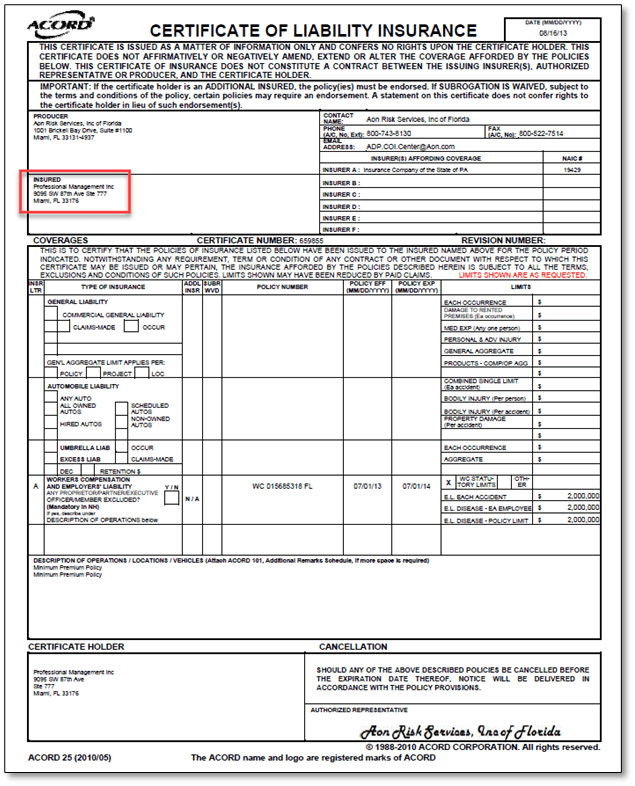You meet with an ADP Run Client and the client does not know what they are contributing towards health. You get all of their client data and medical documents. Which reports can you use to help them figure out what their employer contribution is?
Payroll Details- Look at the deductions column (medical)
Invoice- Monthly Premium
Bonus: Open up EE Info Data Spreadsheet, create a column for monthly premium, another column for employee deductions (then multiplied by payroll frequency/12). Subtract the monthly deductions from monthly premium and that total is what the Employer is paying.
True or False: You cannot couple a traditional health FSA and an HSA simultaneously with ADPTS HDHP plans.
True. If you are on an HSA plan with ADPTS you cannot have an FSA plan as well.
True of False: Workers Compensation is designed to cover ONLY medical expenses after a work-related injury.
FALSE. It also covers lost wages, rehab, and disability benefits.
Scenario: You're trying to gain access with an ADP Run Client with 48 employees that is in the Wholesale industry. They have a renewal coming up in June, the owner answers the phone. What is your Gaining Access message?
Role Play this out. Do they get the point?
You make a cold call to a Best Fit Vega client and the owner tell you, "I can't afford to make a change right now." Overcome this.
"I bet, and I've been hearing that a lot recently. Let me say this I don’t want you to change a thing right now.. Just evaluate because not evaluating could cost you more than staying status quo.”
Which Payroll Taxes are paid by Employers?
- Social Security, taxed at 6.2% for employees and 6.2% for the employer up to the taxable earnings cap
- Medicare, taxed at 1.45% for employees and 1.45% for the employer
- State unemployment taxes (varies by state)
- Federal unemployment, taxed at up to 6% for the employer on the first $7,000 paid to the employee
What is the difference between Pet Insurance and Pet Wellness? (Hint: Think Wagmo)
The major difference between wellness coverage and pet insurance is that pet wellness is used for routine visits and procedures while pet insurance is used for emergencies and illnesses.
Underwriting: Pet insurance requires customers to go through an underwriting process where details such as pet age, breed, and prior medical conditions may need to be disclosed to determine a price. Pet wellness does not have an underwriting requirement—pricing is fixed across all covered pet types.
True of False: Workers Compensation benefits are tax-free for employees.
True
At the end of your EO you've just explained the documents we need for underwriting. The Prospect tells you that they will get you everything except the renewal because they don't want you to just "undercut" their rates. Overcome this.
We cross check your invoice to your renewal to make sure they match. Additionally we require visibility into the group’s renewal and historical plan performance which is why we don't ask for individual questionnaires. This is a core part of our underwriting process to make sure we are not allowing poorly performing groups into our book of business.
True or False: TotalSource Select Clients cannot use the ancillary benefits, but will have access to Voluntary Benefits (Term Life, Voluntary Disability- Short and Long Term, Legal, Online Commuter Benefits, Lifemart, & EAP).
True. Ancillary benefits like Dental, Vision, Life, and Disability, are defined as employer sponsored plans which they would not have on TS Select.
Voluntary Benefits are not employer sponsored and funded 100% by the employee. These benefits are offered by MetLife and include the following:
Voluntary Term Life, Voluntary Disability (Short and Long Term), Legal, Hospital Indemnity, Accidental Death & Dismemberment
These benefits would be offered in the TotalSource Select offering.
We do have additional services TotalSource offers that also need to be taken into consideration:
Flexible Spending Accounts (FSA) – would not be offered under TotalSource Select
Limited Purposed Flexible Spending Account (LPFSA) - would not be offered under TotalSource Select
Online Commuter Benefits (OCB) – would be offered under TotalSource Select
Lifemart Discount Program – would be offered under TotalSource Select
Employee Assistance Program (EAP) – would be offered under TotalSource Select
Health Advocate – would not be offered under TotalSource Select
What does reciprocal state or reciprocity agreement mean for taxes?
A reciprocity agreement mean that two states allow its residents to only pay tax on where they live—instead of where they work.
This is particularly important to higher wage earners who live in states with wide differences in tax rate compared to work in state.
For example, Pennsylvania and work in New Jersey. Pennsylvania’s top rate is 3.07%, while New Jersey’s top rate is 8.97%.
In an HDHP plan, members are responsible for paying the "Negotiated Copay's" prior to reaching their deductible. In this plan, who distinguishes what that amount is?
In an HDHP the doctor decides the negotiated rate, with traditional plans the carrier decides what the copay rate is.
When does Workers Comp coverage start with TS clients?
As soon as we start collecting hours. So beginning of their first pay period on TS.
Scenario: You're showing pricing in your proposal and the prospect asks how we bill our administrative fees. You explain but they then ask, "Why do you charge a % of payroll versus a flat fee?" Overcome this.
"ADP charges our service fee as a percentage of payroll in an effort to increase clarity. Today, our clients pay the majority of their employee-related expenses as a percentage of payroll. For example, workers’ comp and employee taxes like SUI, FUTA, and FICA are all paid as a percentage of payroll already."
How does ADP TS determine a companies HQ address?
For TotalSource, this is influenced by where the benefit offering is based. It is not necessarily where the majority of the employees are located.
IF there are questions about the Headquarter location, the address that is used on the Corporate Tax returns and 940 will be the determining factor.
Scenario: A company that has all employees working in GA, however one employee lives in NC but commutes into work at the GA HQ location. Which state would this employee be in for SUI?
Georgia. NC does not have a reciprocity agreement which mean that two states allow its residents to only pay tax on where they live—instead of where they work. So SIT/SUI should all be in GA.
What is the difference between an HMO and an EPO plan?
HMO plans on ADPTS you will need to designate a Primary Care Physician, but no gatekeeper scenario where they need a referral.
As of 2025, the maximum penalty OSHA can fine per serious injury is closest to:
A) $7,000
B) $15,000
C) $25,000
D) $60,000
B. $15,000
Fun Fact: The #1 Most Frequently Cited Violations published by OSHA is fall protection.
Overcome this objection: "ADPTS charges a % of payroll and because we increase our wages annually we don’t want our admin cost to increase because of it."
First ask them, “Is it typical for you to give your employees raises more than once a year?”
If their answer is “no”, then let the prospect know, “Your HR Business Partner and Service Team have a meeting with you annually to review your wages and fees that you are paying so that we can make sure you are staying within the dollar amount we agreed upon. This way, as you are growing your payroll wages each year, we can continue to lower our admin fee percentage to remain competitive.”
Closed Deal Paperwork: Which 2 Entity Types do not require us to get an SEI Form signed?
(LLC / S.Corp / Partnership / C.Corp / Non-Profit / LLP / Professional Association)
C.Corp and Non-Profit
What makes up FICA?
Federal Insurance Contributions Act
Social Security and Medicare. 7.65% is the FICA rate.
Social Security- 6.2%
Medicare- 1.45%
True or False: The below Employer HSA Contribution Strategy is allowed for ADP TotalSource clients.
Employee Only: $300
Employee + Child: $350
Employee + Spouse: $400
Employee + Family: $500
False. Under ADTS, the Employee/Child and Employee/Spouse contribution amounts must be the same.
True or False: OSHA Reporting/300 Logs are included in the service offering for both TotalSource and Comprehensive HR Clients.
False. OSHA Reporting/300 Logs are provided for TS clients and not included for Comp HR.

You find out the prospect you're meeting with is level-funded with Aetna. Role play how you would explain what the difference is between level-funded and fully-insured?
In a traditional level funded arrangement you are now sharing the risk with the carrier. To give you an example, if you’re looking at $1, only about 30% of that dollar you’re paying into towards your premium is going towards your claims funding. The rest of that 70% is going towards things like your stop loss insurance, broker commissions, and fees. So higher utilization results in stop loss utilization, and increased rates because you’re going into a surplus, which means your in a deficit because you're not collecting enough premium to go towards your claims funding. So you see that made up when it comes time for renewal with higher increases."
If SBS sends a lead to Comp Services and the Comp Services DM on the EO uncovers a PEO opportunity. The CS DM then sends it to the TS DM1. What is the TS DM's split %?
Under 50EE
SBS> CS > TS
67.5%

What is IRS Form 8973? (Hint: Every TS Client signs this)
Clients sign this form during implementation notifies the IRS that a service contract between a CPEO and a customer has started or ended.
Explain the difference between Embedded and Non-Embedded deductibles?
An "embedded medical plan" refers to a health insurance plan, particularly a family plan, that includes an individual deductible and a family deductible, with the individual deductible also contributing towards the family deductible. This means that when a family member meets their individual deductible, their insurance benefits kick in, even if the family deductible hasn't been fully met.
Example: Imagine a plan with a $3,000 individual deductible and a $6,000 family deductible. If one family member incurs $3,000 in medical expenses, their insurance benefits start, and the $3,000 also counts towards the $6,000 family deductible. If other family members haven't spent at least $3,000 each, their benefits won't kick in until the total family deductible is met.
In the instance where a TS client needs to show proof of coverage for a subcontract and the EMR letter is not accepted, what else will TS provide for them as proof of coverage?
Minimum Premium Policy
- Used when a client wants to show proof of WC coverage without disclosing that they are on a PEO
-This is important to prospects that bid on projects

Your in the final stages of closing and your prospect says, "My broker told me if I join TotalSource then we lose our Section 125 benefit." How would you overcome this with the below scenario?
The company has been seeing 10%+ renewals YOY and is trying to get to $6 Million in Revenue this year. All 25 Employees take the benefits. Every employee contributes $300/Month towards their benefits.
To calculate employer savings from offering a Section 125 Plan, you primarily will look at FICA tax savings, because employee pre-tax contributions reduce the employers taxable payroll.
Formula: Employer Savings = Total Pre-Tax Contributions X 7.65%
Step 1: Add up Employee Pre-Tax Contributions (health insurance premiums, dental/vision premiums, FSA and HSA contributions- if made pre-tax via payroll)
Example: Employee Contributes $300/Month so $3,600/year
Step 2: Multiple by the Employer FICA Tax Rate (7.65%)
Example: So $3,600 X 7.65% = $275.40 in Employer FICA Savings for that employee
Step 3: Multiple by Total Number of Participating Employees
Example: 25 employees X $275.40 = $6,885 in annual employer tax savings.
What is GA3's Annual Quota for the year?
$2.6 Million